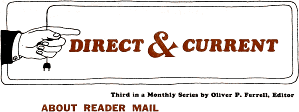November 1970 Popular Electronics
 Table of Contents Table of Contents
Wax nostalgic about and learn from the history of early electronics. See articles
from
Popular Electronics,
published October 1954 - April 1985. All copyrights are hereby acknowledged.
|
You probably will not be
surprised to read Popular Electronics magazine editor Oliver Ferrell's comments
in this 1970 issue
on the costs and implications of handling the large volumes of postal mail from
readers that magazines typically received. Not having e-mail back in the day had
both its advantages and disadvantages. The main advantage of having just paper and
envelope mail (aka snail mail) is that only serious people with concerns would bother
to write and pay for postage, whereas with e-mail very little effort and no out-of-pocket
cost is required to fire off a note for any reason. A disadvantage of not having
e-mail is that humans needed to open, read, and decide how to respond to each letter,
whereas software algorithms - nowadays referred to as artificial intelligence
(AI) - can do the heavy lifting with e-mail.
Direct & Current: About Reader Mail
 Third in a Monthly Series by Oliver P. Ferrell,
Editor Third in a Monthly Series by Oliver P. Ferrell,
Editor
Several years ago, an associate proposed a unique solution to the problem of
how to handle reader mail - never answer a single letter! Undoubtedly he was embittered
by the seemingly endless flow of letters from Popular Electronics readers.
Trying to answer reader mail is admittedly a moral obligation for the magazine
- especially in regard to published material. However, all readers may not be aware
that, as much as the staff would like to help solve reader problems, it is frequently
impossible. Permit me, on behalf of the staff, a moment to review the problem and
explain why some inquiries go unanswered:
1 Cost. Answering the average inquiry costs more in man-hours than the magazine
recoups from a one-year subscription.
2 Validity. The average inquiry wants us to change into something else something
that has already been published; frequently an incredibly complex redesign of the
entire project.
3 Out of Date. An amazingly high percentage of inquiries deal with material published
3 to 10 years ago involving projects using components no longer available and lacking
substitutions.
4 Referrals. The average inquiry is addressed to the author and an answer is
expected over the author's signature. Only one out of 20 authors has the time and
research facilities to answer reader inquiries; as much as he may appreciate the
interest in his work.
5 Volume. Last year, Popular Electronics received an average of 900 letters and
postcards each month that might be categorized as reader inquiries. (We are not
referring here, of course, to the use of the Reader Service Pages.)
In one recent batch of mail, the inquiries included the following samples: design
of a recording studio fader console; comparison of various CB transceivers; pleas
for free subscriptions; detailed theoretical analysis for a Science Fair project;
complaint about absence of Carl & Jerry series; 17 modifications of the" Mini-DVM",
9 requests for clarification of JK flip-flop article; plans for 14 different speaker
enclosures; etc., etc.
The above skims the surface of the problem and is written to show that we are
aware of the need for a quick advisory service. The staff attempts to answer as
many inquiries as time will permit, but those answered are still a fraction of the
incoming mail. Any suggestions?
Posted February 13, 2024
(updated from original
post on 8/7/2017)
|









 Third in a Monthly Series by Oliver P. Ferrell,
Editor
Third in a Monthly Series by Oliver P. Ferrell,
Editor 